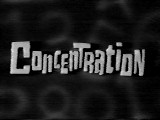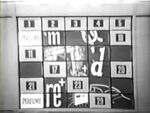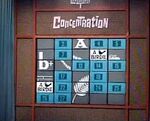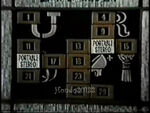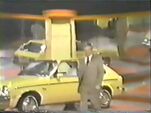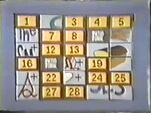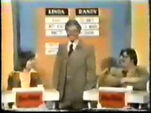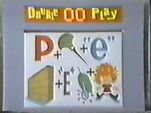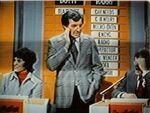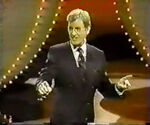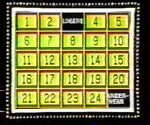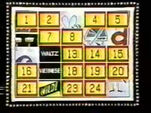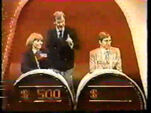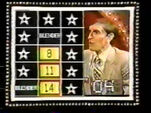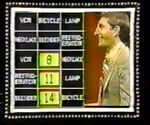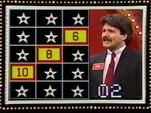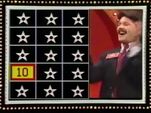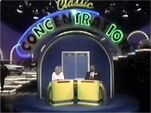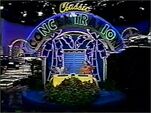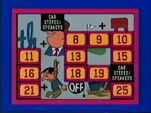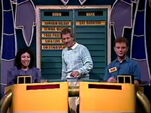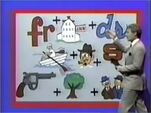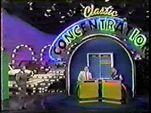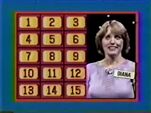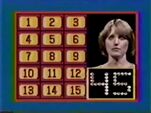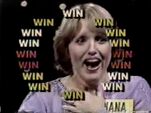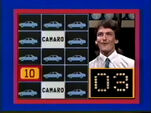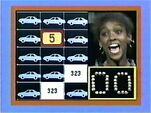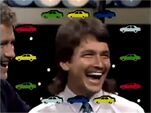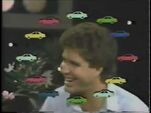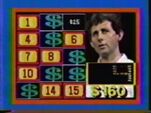(Formatting.) |
(Comma goes between New York City and NY.) |
||
| Line 307: | Line 307: | ||
==Studios== |
==Studios== |
||
| − | NBC Studios 3A and 8G, New York City NY (1958–1973 Daytime Version)<br /> |
+ | NBC Studios 3A and 8G, New York City, NY (1958–1973 Daytime Version)<br /> |
Studio A, NBC 67th Street Studios, New York City, NY (1958 Primetime Version)<br /> |
Studio A, NBC 67th Street Studios, New York City, NY (1958 Primetime Version)<br /> |
||
Ziegfeld Theater, New York City, NY (1961 Primetime Version)<br /> |
Ziegfeld Theater, New York City, NY (1961 Primetime Version)<br /> |
||
Revision as of 18:54, 22 September 2018
| Hosts | |
| Hugh Downs (1958–January 1969) Jack Barry (1958, nighttime) Bob Clayton (January–March 1969, September 1969–March 1973) Ed McMahon (March–September 1969) Jack Narz (September 1973–1978) Orson Bean (1985) Alex Trebek (1987–1991) | |
| Models/Hostesses | |
| Paola Diva Annette Cash Liz Gardner Marilyn Grey Pat White Diana Taylor (1987) Marjorie Goodson-Cutt (1987–1991) | |
| Announcers | |
| Art James (1958–1961, sub in 1991) Bill McCord (1958) Jim Lucas (1961–1963) Bob Clayton (1963–1969) Wayne Howell (1969–1973) Johnny Olson (1973–1978) Gene Wood (1985–1991) Rich Jeffries (1987 Test Show) | |
| Broadcast | |
| NBC Daytime: 8/25/1958 – 3/23/1973 NBC Primetime: 10/30/1958 – 11/20/1958, 4/24/1961 – 9/18/1961Syndication (Daily): 9/10/1973 – 5/19/1978 (reruns aired until 9/8/1978)Unsold Pilots for Daily Syndication: 5/1985Test Show: 4/25/1987NBC Daytime: 5/4/1987 – 9/20/1991 (with repeats through 12/31/1993)Unsold Runthrough for NBC Daytime: 11/1992 | |
| Packagers | |
| Barry & Enright Productions (1958) NBC Productions (1958–1973) Mark Goodson-Bill Todman Productions (1973–1978) Mark Goodson Productions (1985–1992) | |
| Distributor | |
| Jim Victory Television (1973–1991) | |
(Classic) Concentration was a TV game show based on the children's memory game of the same name. It aired on and off from 1958 to 1991, hosted by various hosts and played in various ways. The property has been seen in several different versions:
The original network daytime series, Concentration, aired on NBC for 14 years, 7 months, and 3,770 telecasts (1958-1973), the longest run of any game show on that network (Wheel of Fortune was a month shy of tying that record when the initial NBC run ended on June 30, 1989). This series was hosted by Hugh Downs and later by Bob Clayton. For a six-month period from March to September 1969, Ed McMahon hosted the series. The series began in the 11:30 a.m. (Eastern) time slot, then moved to 11:00 AM and finally to 10:30 AM. Nearly all episodes were produced at NBC's studios at 30 Rockefeller Plaza, New York City.
A once-a-week nighttime version of the show appeared in two separate broadcast runs on NBC. The first edition appeared only for four weeks in Fall 1958 with Jack Barry as host. The second edition was on the air in 1961 with Hugh Downs as host.
The second version of Concentration, which was the first to be played in southern California, ran in syndication from 1973 to 1978 with Jack Narz as host.
A pilot for a third version of Concentration was attempted in 1985. The pilot was hosted by Orson Bean, but no network or syndicator bought the show. However, after some reformatting, a remake of the game called Classic Concentration, hosted by Alex Trebek, aired on NBC from 1987 to 1991 (with reruns airing through December 31, 1993).
Despite numerous attempts to develop a new version in recent years, NBCUniversal (the rights holder) has not yet authorized a new version of the program.
Development
Barry and game show partner Dan Enright, along with Robert Noah and Buddy Piper, created Concentration, but others working at Barry & Enright Productions also contributed to the show's development. (The full end credit roll after the NBC takeover had a title that read "Based on a concept by Buddy Piper.") The creation involved the combination of two key creative concepts: the children's game of matching cards, and the use of a rebus puzzle that was revealed as matching cards were removed from the board. In place of the playing cards, the game board featured numbered boxes (30 in all) on one side and prizes, that were to be matched, on the other. The gradual matching of card pairs slowly revealed elements of the rebus, a picture puzzle described below.
Rebuses
The rebus form is centuries old and has been used in various forms. The most popular contemporary form prior to Concentration involved pictures, letters, and numbers as well as plus and minus signs to add or delete parts of a word or phrase (e.g., WICK + E + PEA + D + UH; or, with minus signs, WICK + ELEPHANT - LEPHANT + PIE - IE + D + UH.)
The member of the Barry & Enright development team responsible for the development and art direction of the puzzles was Norm Blumenthal, who later became the original series' producer. He simplified the rebus form for television, allowing only plus symbols, and subsequently devised all of the puzzles seen on the original series. In his version of a rebus puzzle, which became Concentration's standard, a rebus is a puzzle made up of a combination of pictures, letters, words, and numbers connected by plus signs. When solved, it is either the title of something or a well-known phrase. For instance:
- A picture of a convict (CON)
- A plus sign
- A picture of a penny (CENT)
- A plus sign
- A picture of a serving tray (TRAY)
- A plus sign
- A picture of a human leg, shin highlighted (SHIN)
Hence, CON + CENT + TRAY + SHIN (CONCENTRATION).
Rules
Two contestants (one a returning champion) sat before a board of 30 squares, which concealed the rebus, names of prizes and special squares.
One at a time, the contestants called out two numbers. If the prizes or special action did not match, the opponent took a turn. However, if the contestant did match, whatever prize was printed on the card was placed on a board behind the them; or, he/she could perform an action. The second number had to be called out within a certain time limit; otherwise, the contestant's turn ended. It was also permissible to pass on one's turn. This usually happened during the course of a game if a contestant called out a prize card that had been orphaned as the result of a Wild Card match (see below).
More importantly, a match also revealed two pieces of the rebus, which identified a person, phrase, place, thing, etc. The contestant could try to solve the rebus by making one guess or choose two more numbers. There was no penalty for a wrong guess; even if he/she was wrong, he/she kept control. Usually, a contestant waited to solve the puzzle until they had exposed a good portion of the rebus through several matches. In rare instances, the puzzle was solved with only a few clues showing. On one occasion, it was solved with only two clues.
In addition to the prize cards, there were the following action cards:
- Wild Card – Provided an automatic match. In the original game this left the natural match "orphaned", only able to be matched by the other Wild Card, of which there were only two on the board. If the contestant matched the same prize to both Wild Cards, a check mark would be placed next to the prize on the their board, and that contestant would win two of that prize if he/she solved the puzzle.
- Contestants uncovering both Wild Cards simultaneously also won a bonus. At first, contestants won $500 (theirs to keep regardless of the game's outcome) and chose two additional numbers; the prizes went on that contestant's side and four pieces of the rebus were revealed. Late in the run, the bonus was changed to a new car, and again the player kept it, regardless of the game's outcome. Only one car was awarded to a contestant if they called a "Double Wild Card."
- Take One Gift – There were two of these cards in each game. If a contestant matched them, he/she could take their choice of any of the prizes listed on their opponent's prize board. Of course, the game had to be won to receive all prizes listed on their prize board.
- Forfeit One Gift – There were six of these in each game. If a contestant matched two of them, they had to forfeit one prize to their opponent. Naturally, they would give up the least expensive, but sometimes had to give up something very valuable (if that was the only one on their board).
Also included were two or three joke or gag prizes (such as a banana peel or a tattered sock; over the years, the gag prizes would be comprised of some creatively bad puns and wordplay). These actually served as protection against matching the Forfeit cards the contestants could stumble upon. During a panel discussion of the series at the 2005 Game Show Congress, producer Blumenthal stated that the cash value of the gag gifts was $1.
If a contestant solved the puzzle, they won all of their accumulated prizes which were theirs to keep. If there were no legitimate prizes in the rack, they were awarded $100. The loser forfeited all his/her gifts accumulated in that game, but still received token parting gifts as well as the show's home game. There was no bonus round in the original game.
Occasionally, a game would come down to where only two prize cards were left on the board, which because of the Wild Cards often did not match. In such instances, the unmatched cards were turned over to reveal the entire puzzle, and the contestant who made the last match was allowed one guess to try to solve it first. If he/she guessed incorrectly, their opponent was allowed to make one guess. If both guessed incorrectly, the game ended in a draw. A new game was played and each contestant was allowed to carry over a maximum of three prizes.
Champions continued until they either were defeated or won 20 games. This was only achieved twice in the show's entire run.
NBC (1958–1973)
Concentration remains the longest-running game show on NBC and held the record for longest continuous daytime run on network television until it was eclipsed in April 1987 by the CBS daytime version of The Price is Right (beginning on September 4, 1972). It has been currently the fifth longest-running daytime/syndicated game show behind The Price is Right and the syndicated versions of Wheel of Fortune (1983–Present), Jeopardy! (1984–Present) and Family Feud (1999–Present).
As a result of the quiz scandals, co-creators Jack Barry and Dan Enright, upon their blacklisting from television, were forced to relinquish the rights to NBC, who holds the rights to this day. Apart from the earliest episodes, Concentration was an NBC in-house production.
Concentration’s original host was Hugh Downs and was produced and broadcast live at 11:30 AM Eastern weekdays in black-and-white, and quickly became the most-watched daytime series in NBC's lineup. The announcer was Art James, who sometimes served as a substitute host and later became a game show host in his own right. The series was produced in NBC's Studio 3A which housed, as of January 2009, NBC News and MSNBC.
The series then moved to 11:00 AM and slowly introduced color broadcasts. For a picture puzzle game whose rebuses were designed and painted in monochrome, this required some design changes: The colors of the numbered cards might otherwise interfere with the colors used on the rebus, a critical issue for contestants playing in the studio and for viewers who played along at home. During this period, the series was produced in NBC's Studio 6A. Hugh Downs, by this time also an anchor correspondent on NBC's Today Show, remained host, and the announcer became Jim Lucas, who also worked on NBC's local New York radio station, WNBC-AM. September 1965 witnessed the show move to 10:30 AM where it would spend the remainder of its run on NBC.
In January 1969, Downs stepped down to devote his entire attention to Today with Bob Clayton, who had succeeded Jim Lucas as announcer, taking over the hosting duties. In March, NBC set Clayton aside in favor of Ed McMahon due to advertiser pressure, but Clayton returned in September and remained host until the series ended. On the Monday following the show's demise on NBC, Clayton became the announcer for The $10,000 Pyramid on CBS. NBC staffer Wayne Howell replaced Clayton in the announcer's booth.
The first puzzle was "It Happened One Night", and the last puzzle read "You've Been More Than Kind".
Seen daily for nearly 15 years, and consistently one of the most popular series on NBC, the original series included many special features. These included special salutes to individual nations around the world, annual specials saluting the Boy Scouts, annual Christmas shows featuring "Secret Santas" (celebrities who played the game in Santa Claus suits and revealed their identities at the end of the show), and the Challenge of Champions (so successful that it was subsequently mimicked by another popular NBC daytime game, Jeopardy!). Among the series' popular special features:
- The Envelope and its Mysterious Contents – The winning contestant opened a sealed envelope and read its message aloud (as if he/she were the show announcer). Generally, it mentioned an inexpensive prize and further reading proved it to be an expensive prize, such as large amount of cash or a new car.
- The Cash Wheel – A contestant spun a carnival-type wheel, containing various dollar amounts. The top prize was $2,000.
- Christmas shows featured children from United Nations countries, as well as Secret Santas included Joe Garagiola, Victor Borge and other celebrities. Proceeds went to C.A.R.E., which built two schools in Africa from funds raised by the series (Blumenthal and Downs received awards from C.A.R.E.).
- International Salutes – All prizes in these games were from the specific country saluted. In a salute to Mexico, for example, contestants wore sombreros, Downs would be dressed as a matador, and model Paola Diva would play a colorfully costumed señorita driving a mule-driven cart.
- An annual Boy Scout Show. It saluted famous Americans who were scouts. Den Mothers and scouts played the game and won prizes for themselves and their troops. Girl Scout shows also became an annual event.
- The Challenge Of Champions – Beginning in 1963, Concentration inaugurated a tournament of champions, which pitted the top four players of the previous 12 months in a best-of-seven tournament (styled à la the World Series). The grand prize was $1,000, a trip around the world and a special trophy dubbed "The Connie", modeled after Auguste Rodin's The Thinker; one of the participants in the very first tournament was Brooklyn Dodgers pitcher Ralph Branca, who won 17 games on the show.
Throughout the competition, participants, including Downs, Clayton, and Blumenthal, wore blue blazers with the show's logo, known as the "mystery logo", embroidered in gold on the breast pocket. The "mystery logo" blazers continued to be a part of the emcee's wardrobe up until the show ended its original run in 1973.
During another contest (circa 1970), home viewers could win a prize based on the initial of their last names corresponding to a number on the board. To enter the contest, one merely had to send a postcard to the address given. These postcards were placed in a rotary drum and Clayton would draw a card and read the name. If the prize card was for a gag prize or a "Forfeit One Gift", the home viewer received $100. If it was a "Take One Gift" card, a $250 prize was awarded. If it happened to be a Wild Card, the home viewer won $500. The contest was held at least once a week and frequently several drawings were held on the same episode.
On one episode, a viewer from Oklahoma won a motor boat. Host Bob Clayton made the mistake of asking "What could he possibly do with a boat in Oklahoma?" The show was then inundated with brochures on Oklahoma lakes. Most Oklahoma lakes are man-made, in response to the Dust Bowl.
Through nearly all of the original series' run, the program was produced by Norm Blumenthal. He also created every one of the 7,300 puzzles used on the show (with no repeated puzzles). He also created all puzzles used in the 24 editions of the Milton Bradley home game.
One retrospective of the original series reported the following prize tally:
- 512 cars
- 397 boats
- 1,287 domestic and foreign trips and cruises
- 12 trips around the world
- 857 fur coats
Additionally, there were countless gift certificates, travel trailers, airplanes, swimming pools, furniture, kitchen appliances (large and small), rooms of furniture, clothing, stereos and televisions, fantastic nights out on the town and virtually any other item seen in any mail-order catalog. One history of the 1958-1973 series reported the total prize giveaway at $10 million.
The prize values on the original series were deliberately much smaller than those of the big-money games implicated as part of the quiz show scandals of the late 1950s. Barry and Enright kept the winnings low-value on purpose, to avoid any suggestion that it, too, was tainted; NBC maintained that policy when it took over production. Usually, there was at least one prize worth more than $1,000; however, nearly all the other prizes were worth less than $500, with many in the $10-$100 range. A board of prizes rarely totaled more than $2,000-$3,000 and champions rarely took home more than that in merchandise during their stay (though some longer-lived winners approached $10,000).
During most of the network version's run, it faced sitcom reruns on CBS and local programming on ABC affiliates, easily dominating them in the ratings. However, in late 1972, CBS launched the new version of The Price is Right at 10:30/9:30, which drained more than half of the Concentration audience. NBC concluded that the game had reached the end of its natural life cycle and canceled it seven months after Price began. A Merrill Heatter-Bob Quigley production, Baffle hosted by Dick Enberg, replaced it at that time slot.
Gallery
Syndicated (1973–1978)
Five months after NBC canceled Concentration, Mark Goodson-Bill Todman Productions produced a daily five-a-week version for syndication. The project was a joint venture of syndicator Jim Victory and NBC, which retained the rights to the show, the only program not to have been created in-house by Goodson-Todman. The show premiered on September 10, 1973 and ran for five years. Jack Narz was host, with Johnny Olson serving as announcer. This version of Concentration was produced at Metromedia Square in Hollywood, and aired primarily on NBC stations that had carried the original series; this essentially meant that the show returned to NBC with a new set and host (plus a slightly different format) after a short "hiatus".
This time, two new contestants competed each day and there were no returning champions (some stations only carried the show one evening each week). Games did not straddle episodes as on the network version (again due to some stations only carrying the show once-weekly). For the first two years, the basic game was identical to the NBC version with the addition of four "head starts" that revealed half the locations of four prizes on the board. The "gag prizes" were gone and only one pair of "Forfeit One Gift" cards remained, with three pairs of "Take One Gift" cards this time. The show's board had become very colorful with the 30 larger numbers in red with yellow backgrounds and red frames. Many prize, "Forfeit", "Take", and "Wild Card" spaces had actually come from New York with the original board and were reverse-printed (white lettering on a dark background). The rebus was in full color on a sky blue background.
The cash prize was increased when a contestant solved the puzzle with no prizes on his/her side of the board (from $100 to $250). The bonus for matching the two "Wild Card" spaces regardless of winning the game reverted to $500 instead of the new car last offered by NBC. Also, the contestant no longer received the opportunity to match the "Wild Card" spaces and reveal four parts of the puzzle. Prizes that were once only consolation prizes on the NBC series and other game shows became the prizes on the board. If the board had no more matches and no one solved the puzzle (or if time was running out), the remaining parts would be revealed and a contestant could ring an electric "buzzer" to give his/her solution. In addition, a new space was added, called "Bonus Number". Upon matching this, the contestant could call three numbers per turn, until making a match. There were four "Bonus Number" cards (eliminating one prize pair and one of the "Take One Gift" pairs).
If there was time for a third game, a "money game" would be played. This game was basic Concentration with no head starts. On the board were matched amounts of foreign currency with the usual "Take", "Forfeit", and "Wild Card" spaces. When a match was made, Narz would note the equivalent in American dollars. The player who solved the puzzle was awarded the money in American currency; if the game could not be completed, the contestant credited with more money was declared the winner.
The old board did not suffer the trip to the West Coast well. By Spring 1975 the trilons were "grinding" so badly they could barely turn; that Fall, the board was completely rebuilt with a smooth high-speed mechanism that made the trilons almost fly around.
Double Play
The winner of the game played a new bonus round called "Double Play" with a new car as the prize for solving two fully-revealed rebuses on a separate board within 10 seconds. Solving the first puzzle earned the player $100; then if s/he solved the second rebus before time ran out s/he won the car, the first of which was a yellow 1973 Chevrolet Vega hatchback.
Changes
Beginning in Fall 1975 and continuing through Spring 1976, more rules were changed to speed up gameplay. "Forfeit One Gift" was scrapped entirely. The board now hid two "Free Look" spaces - revealing one instantly uncovered that particular portion of the rebus and allowed the contestant who selected the space the option of taking a guess at the puzzle. Two more "Wild Card" spaces were added to the board and the prize for matching them was reduced to $250. Contestants could now call a third number in the first game if the first two picks did not match (later changed to having a third pick in both games). All of the remaining original trilon cards were scrapped and replaced with new graphics. The rebuses were also made shorter and easier, all trends that later made up Classic Concentration.
Unfortunately, despite these changes the show's ratings fell and many stations (including flagship WNBC-TV in New York) moved the show to either pre-dawn hours or other non-prime-time access slots and dropped it in Spring 1976. Some independent stations then picked up the show.
Beginning in Fall 1977, the "Double Play" bonus game added a step: Players determined their Double Play prize package by choosing squares from a 9-space board and competing for the first prize package matched (the car was still available as a prize on this board). The Wild Card was also there, and if found, it allowed the player to play for all of the prizes revealed up to that point.
Another change was the reversal of the contestant and board locations, oddly common among game shows originally produced in New York and moved to the West Coast. The contestants now sat on the right side of the studio, with the board positioned on the left. There was no emcee's podium and through Spring 1976 Narz was mainly off-camera during the game, standing in the center of the stage; beginning in Fall 1976, he began standing between the two contestants. The prize tote board consisted of the two doors that were originally on the New York set, but cut down and made permanently-set boards in the new set. A single bell chime sounded whenever a match was made.
This version of Concentration also used several prize music cues also used on The Price is Right. The music for a Double Play win on Concentration has also been used since the 1970s as pricing-game music in which the prize is a car.
Gallery
"Concentration '85" (1985)
In 1985, ten Concentration pilots were taped with comedian Orson Bean as host and Gene Wood announcing.[1] The revival may have been intended for syndication, as the end credits state that the show was "Distributed by Victory Television, Inc."
Two contestants competed, as in prior versions, to match squares and uncover parts of a picture puzzle in the form of a rebus; like the Narz version, solving it won the game and an attempt at the bonus round. The format, however, had been altered to use distinctly different elements - some of which were not seen before or since.
Main Game
Instead of matching prizes, contestants matched related words on a computer-generated board (now with 25 squares instead of the 30 used through 1978) and were credited $100 for each "match". Two "WILD!" cards were also present, and matching one of them with a word would also reveal its "proper" match and give the contestant three parts of the puzzle; no mention was made of any bonus for matching the Wild Cards.
The first contestant to solve the rebus won whatever money they had earned (no mention was made of what would happen if a contestant solved with no money) and played the bonus game.[2]
Bonus Round
The bonus round had also changed from that last seen in 1978 - now, the contestant faced 15 numbered panels (also computerized), on which were the names of seven prizes (with an eighth as a decoy to distract the contestant); the contestant would call numbers in an attempt to match prizes, each one matched being theirs to keep regardless of the outcome. If the contestant managed to match all seven prizes in 50 seconds (plus another 10 each time this did not happen), they won a $5,000 bonus in addition to all seven prizes.[3]
Returning champions
There were no returning champions; two new contestants played each episode, which consisted of two full rounds of play, each with a puzzle and a Bonus Round.
Episodes & Status
According to Wink Martindale, ten episodes of this new version were taped. To date, only two episodes have been made available on YouTube; the above episode and a second posted by Mr. Martindale himself. The status of the other eight pilot episodes is unknown.[4]
Gallery
Classic Concentration (1987–1991)
The most recent version to date was hosted by Alex Trebek and Marjorie Goodson-Cutt (after Diana Taylor served as model for the first few weeks). Gene Wood served as primary announcer for most of the run (Art James filled in for Wood, just weeks before the series cancellation). It aired in first-run on NBC from May 4, 1987 to September 20, 1991, after which it went into reruns until December 31, 1993.
Many elements of Classic Concentration were actually recycled from the failed pilot taped two years earlier - the show's theme, the computerized 25-square board, the bonus game, and Gene Wood as announcer.
Main game
This version featured a computer-generated GUI board, with the contestants looking at the puzzle board on a large-screen TV placed out of view of the cameras; however, there were 2 separate TV monitors, one for the numbers and the other for the prizes concealed behind them. Gameplay was the same as the 1985 pilot; however, it reverted back to matching like-named prizes.
Most games had three "WILD!" cards (although some games used only one or two). Choosing two WILD cards in one turn earned the contestant a $500 bonus, and if a third was chosen in the same turn the bonus doubled to $1,000. As with the other prizes, cash bonuses could only be won if the contestant solved the rebus.
Two pairs of matching-colored "TAKE!" cards, one red and one green, also appeared. In the earliest episodes, no TAKE cards appeared on the board, and for a short time the green TAKE appeared all by itself (after November 11, 1987); the red TAKE was added later (after February 9, 1988). TAKEs had to be matched by color (Green to Green, and Red to Red; a Red and Green pair was not considered a match). In this game, a contestant could choose either to use a TAKE card immediately after matching it on the board, or to save it and wait for a particular prize to show up in the opponent's prize column. The FORFEIT cards found on the original Concentration were not used on this show.
In 1989, a second cash bonus was added to the board with the introduction of the "Cashpot", an accumulating jackpot that started at $500 and added $100 for each game it was not claimed. As with the other prizes, cash bonuses could only be won if the contestant solved the rebus.
When a wild card match was made, the natural match was also located resulting in three puzzle parts being revealed, or more if multiple wild cards were found in one turn. Also, as long as a contestant kept control, while continuing to make matches, then he/she could clear the entire board if need be, including an automatic match, before a contestant needed to solve the puzzle.
The contestant who solved the puzzle first, with the correct solution, won the game and got to keep whatever prizes he/she had won to that point. If incorrect, the contestant was locked out, and the opponent got a free guess. If both contestants were incorrect, then, either one could buzz in after the host began reading the puzzle, by giving one clue for each symbol of the puzzle, until a contestant solved correctly.
In the event that time ran short during a game, the puzzle was revealed square by square, in numerical order (the remaining unmatched prizes were out of play at this point). The first contestant to buzz in with a correct solution won the game. As before, if incorrect, the contestant was locked out, and the rest of the puzzle was revealed for the opponent to receive a free guess. Also as before, if both contestants were incorrect, either of them could buzz in after the host began reading the puzzle, giving clues to the solution of the puzzle until one contestant guessed correctly.
Returning champions
In the beginning of the run, the contestant who solved the rebus went to the Winner's Circle while the loser was eliminated (except in cases of an interrupted game, when the losing player would return to play in the next match as the "challenger"). On July 4, 1988, the format was changed into a best-of-three match, with the first contestant to solve two rebuses winning the match and playing the bonus game. Unlike most game shows that tend to straddle when playing a best-of-three format, Classic Concentration had each match and bonus game fit into one complete show. The first game was split over the first two segments, with the second (and possibly) third game taking up the third segment. The bonus round was played during the fourth segment of the show.
From July 2, 1990 until the end of the run, contestants played the bonus game after solving a puzzle, and would be eliminated from competition after losing two games.
Bonus Round
A player who won a match got the opportunity to win one of eight new cars, valued between $6,000 and $16,000 (sometimes even more), in the bonus game. The contestant was shown a board of 15 numbered panels, instead of 25 as in the main game.
Behind those numbers were the names of the eight cars sitting in the studio. The names of seven of those cars could be matched on the board while one was an unmatchable decoy (early in the run, all of the cars would be displayed before the bonus round began; later shows did that on rare occasions). If the contestant found all seven matches before time ran out, he or she won the seventh and final car indicated in that match. Players were given a base time of 35 seconds, and 5 seconds were added for each unsuccessful attempt. After winning a car, the clock would be reset to the base time.
Upon a win, a graphic of chasing rainbow cars would be shown around the contestant. Though in the first week, there would be a chasing win word around the winning contestant (similar to the rainbow car word chase on Card Sharks).
Early in the show's run, a contestant could win the game and play the Car Game round up to five times before being retired. Later, champions were only retired after winning a car.
Occasionally, a "5 Bonus Car Seconds" prize appeared in the main game. A contestant who solved a rebus and had matched this prize earned five additional seconds in the bonus round.
During some shows, if there was time remaining, an audience member preselected before taping began played the bonus round for up to $500 cash. Instead of the names of cars, dollar amounts of $5, $10, $15, $20, $25, $50, $75, and $100 were hidden behind the 15 numbers. The audience member was given 60 seconds and kept any amounts matched, which accumulated as they went along, or $500 for clearing the board.
Tournament of Champions
Starting in 1988 and continuing annually until the end of first-run episodes, there was a Tournament of Champions. Ten contestants who won the bonus round in the shortest amount of time were invited back to play for a more upscale car and an extra bonus prize -- depending on the year, either a trip around the world, $10,000 in cash, or $25,000 in cash.
Two contestants competed for the same show, playing two front games. For the first show only, the winner played the bonus round with the clock counting up. If the contestant was able to clear the board within the time limit, their time became the new "base time" (e.g., if a contestant cleared the board in 29 seconds, all future contestants had to complete the round in less time to be eligible to win; the clock counting down in all other cases). At the end of the tournament, the contestant who completed the bonus round in the shortest time kept the car they nominally won, plus won the additional grand prize. For the first two tournaments, the winner of each bonus round kept their car like normal.
Other special weeks
Other special weeks included weeks for couples as well as holiday themed weeks.
One such week involved kids and their relatives. In the main game, the kids made the matches (as they would in Memory), but the adults solved the puzzles. The adults also played the Winner's Circle game. One such episode is seen here.
Gallery
Episode status
Nearly all of the 1958-1973 episodes were rumored to have been destroyed by NBC until kinescope recordings of the original series were found (according to Steve Beverly of the Game Show Convention Center website). Some are found at the Library of Congress. Only a few remain on the trading block:
- Shokus Video is known to have two Downs episodes, including a tournament episode from the late 1960s.
- Twelve Downs/Clayton episodes and a syndicated Narz episode have been found in the UCLA Film and Television Archive.
- The Museum of Television and Radio has in its possession one 1958 Hugh Downs episode, two 1971-1972 Clayton episodes and one syndicated Narz episode from 1974.
- The final NBC episode has also remained intact, existing as a color kinescope.
All of the Narz episodes exist (according to Steve Beverly of the Game Show Convention Center website) but have not yet been released as NBC still owns the rights to the series. Two of the ten episodes taped of the 1985 pilot hosted by Orson Bean also exist in private collections (at least one in the collection of Wink Martindale), and are available for viewing on YouTube.
All of the Trebek episodes still exist and have since been converted from analog to digibeta tape (required to air on cable television). The Trebek run will air on Buzzr beginning on October 1, 2018.[5]
GSN has never aired Concentration. It has been theorized that NBC refused to sell the rights to the Narz and Trebek versions.
Rating
Music
- 1958 (Main) – Paul Taubman
- 1958 (Commercial) – "Puppet On A String" by Ramond Lefevere
- 1973 Main Package – Edd Kalehoff for Score Productions, several cues from this package were recycled into The Price is Right
- Main – "Fast-Break"
- 1973 Prize Cues – Score Productions
- "Big Banana"
- "Starcrossed"
- "Splendido"
- 1985, 1987 – Score Productions, based off the Body Language ticket plug
The ticket plug on Body Language was recycled into the 1985 pilots and the Classic version of this show as a prize cue.
Studios
NBC Studios 3A and 8G, New York City, NY (1958–1973 Daytime Version)
Studio A, NBC 67th Street Studios, New York City, NY (1958 Primetime Version)
Ziegfeld Theater, New York City, NY (1961 Primetime Version)
Metromedia Studios, Los Angeles, CA (1973–1978 Syndicated Version)
NBC Studio 3, Burbank, CA (1987–1991)
Trivia
- The panel flip sound from Classic Concentration is used on many Saturday Night Live game show sketches as the ring-in sound. It was also heard on Trivia Trap and the 1989 version of Now You See It. The 1985 pilots used the sound when a Fast Money answer in Family Feud was revealed, while the Face-Off sound was used in a Speed-Up round.
- Concentration was spoofed somewhat by Sesame Street as "The Remembering Game", hosted by Guy Smiley, in which two contestants (Cookie Monster and Bill Smith) had to match two of the same prize in order to automatically win it from a 4-number game board; the two prizes offered were a cookie and a jet airplane. Unfortunately Cookie Monster won the jet, so he decided on a trade with Bill Smith; Bill got his jet, Cookie Monster his cookie. Unlike Concentration, there was no rebus-puzzle element.
Notes
1. Steve Beverly's "The Game Show Convention Center" archive column, 'The Lost Episodes' (August 9-15, 1999)
Additional Pages
Concentration/Quotes & Catchphrases
Concentration/Merchandise
Concentration/Gallery
Concentration/Video Gallery
References
External links
- The Unofficial Concentration Home Page
- James Vipond's Concentration Site
- Concentration... Through the Decades
- Jay's 1985 Concentration Pilot Page
- Joe Madigan's Classic Concentration Page
- A blog about "Classic Concentration"
- David's Concentration Page
- TGSCC article "The Lost Episodes"
- Josh Rebich's Concentration Rule Sheets
- Official Pearson site for "Concentration" (via Internet Archive)
- Flash game for Dream Car Game
- Flash game for Fantasy Car Game
- Flash game for Regular Car Game

